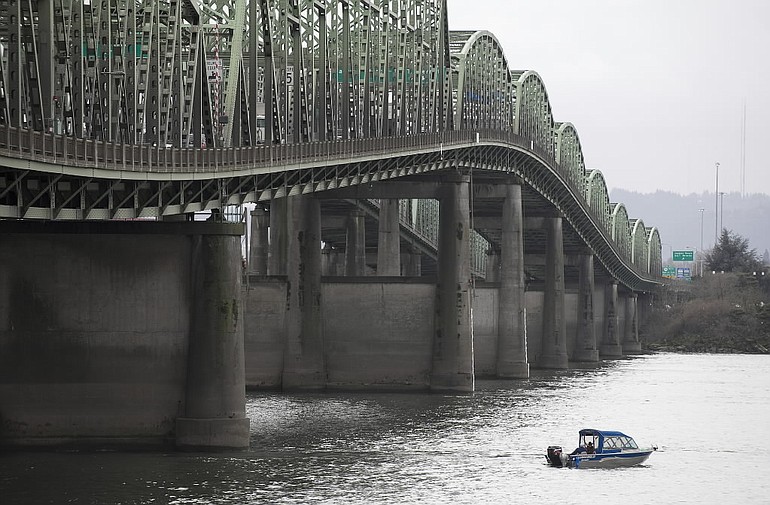A six-lane bridge?
Portland transportation planners have requested a boatload of engineering documents on the much-maligned Columbia River Crossing project, reportedly with the intent of designing a much smaller Interstate 5 bridge — potentially no bigger than the existing twin spans.
The request comes as Vancouver Mayor Tim Leavitt takes criticism over his role in co-authoring a letter with Portland Mayor Sam Adams and others that called the current plan for a 10- to 12-lane bridge “unacceptable.” The mayors, along with Clark County Commissioner Steve Stuart and Metro Council President David Bragdon, called for more local input on the $4 billion project.
Portland now appears to be taking the bull by the horns.
City officials this week requested traffic data as well as engineering plans for the crossing, which includes replacing the existing twin three-lane drawbridges, improving five miles of freeway and extending light rail through downtown Vancouver.
The documents are highly technical, said Don Wagner, the co-director of the bistate crossing office.
Crossing staff asked city officials why they wanted the documents, Wagner said.
“Their response was, they’re looking to go out to a contract to hire a bridge design firm to look at that data and look at a much, much smaller bridge that would be on the magnitude of six to eight lanes,” he said.
Leavitt, stung by the revelation, said such a small bridge wouldn’t serve Vancouver’s interests.
“A six-lane bridge, I’m pretty comfortable saying, wouldn’t be acceptable to our community,” he said.
Adams’ office did not return calls from The Columbian on Tuesday.
The request comes amid fraying support for the project.
In June and July of 2008, the 12-lane “locally preferred alternative” received the conditional support of city councils, transit agencies and metropolitan planning organizations on both sides of the river.
City council chides Leavitt over bridge letter
Support began to wane last year.
Adams and Bragdon caught an earful from constituents who viewed the CRC as a boondoggle that would jam up Portland’s central business district while fueling sprawl in Clark County. Meanwhile, Leavitt made his opposition to bridge tolls a centerpiece of his winning campaign against incumbent Mayor Royce Pollard in November.
Pollard, in his last meeting on the crossing’s 10-member Project Sponsors Council in December, objected to cost-cutting refinements in which engineers proposed slimming the bridge from 12 to 10 lanes. He argued that Vancouver agreed to accept light rail and tolling in return for 12 highway lanes, enough room to forestall congestion until well into the future.
“What the hell do we get out of this deal?” Pollard asked.
After that meeting, Adams was asked what kind of bridge he could support.
“That’s a great theoretical question I’m not prepared to answer,” he said.
An e-mail obtained this week by The Columbian provides some insight.
How many lanes?
The memo between Portland transportation planners lays out several discussion points for the last of four meetings between Adams, Leavitt, Stuart and Bragdon. The first discussion point suggests creating a cooperative “work team” of local and state transportation planners; the second suggests hiring consultants to work with the elected officials and CRC staff.
The third suggests analyzing a “‘down-sized’ CRC alternative.”
How downsized?
Six lanes, total.
“How to make a six lane bridge, with full shoulders, safe and effective at moving people and goods? Possibilities include auxiliary lanes at north end of bridge for SR 14 and downtown Vancouver traffic, HOV ramps and lanes, freight only access ramp,” according to the memo dated Jan. 11, one week before the last four meetings between the four elected officials.
The project would still include light rail, and the span would be high enough to eliminate the drawbridge for boats. It’s not clear whether Portland officials would drop their insistence on tolls if the new bridge has the same number of freeway lanes that it has now. Adams has said tolls should be used to keep rush-hour traffic from clogging central Portland.
Meanwhile, state and federal officials insist that tolls are inevitable to generate the local share of the cost.
Leavitt and Stuart both said they had not seen the memo.
“The only discussions we have had were about the process to get to a product, not the other way around,” Stuart said. “We have had no discussion about what the right number of lanes are.”
He said re-starting the process, already five years down the road, is a “nonstarter” for him.
“Asking for information is one thing,” Stuart said. “Trying to re-design the bridge is a whole other thing.”
Brian Gard, a Portland advertising executive who heads the Columbia River Crossing Coalition, a business group supporting the project, said the organization is focused on the estimated 27,000 construction jobs that will be delayed by further study. Further, the “no-build” alternative modeled by engineers shows traffic congestion expanding from four to six hours a day now to 15 hours of congestion by the year 2030.
Gard said he believes Adams is sincere in his criticism of the project, but the coalition does not support even studying a six-lane alternative.
“It would be such a significant undertaking, that it practically amounts to scrapping what we have and starting over again,” he said. “It would be a tremendous waste of money and time.”
Staff writer Andrea Damewood contributed to this report.



